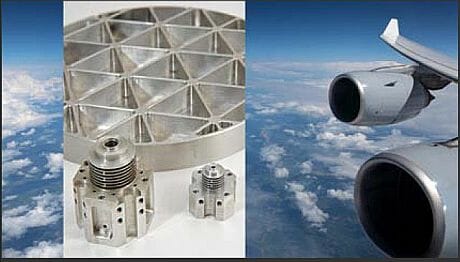
The importance of surface finish in components for the aerospace and medical industries.
Introduction
In the aerospace and medical fields the surface finish of machined components is of utmost importance. High pressure hydraulic systems and fuel injections systems in particular require high quality surfaces and precisely defined features, such as o-ring grooves, if system integrity is to be maintained. In the medical field, equipment manufacturers and pharmaceutical producers demand stringent specifications with respect to surface finish. Literally, lives can be on the line if these systems fail, so it is critical that the quality of the machined components is maintained.
Nuclead Inc. has over 30 years of experience producing components for the Aerospace and medical fields. This article describes the capabilities and expertise available that has made that possible. First though we begin with an explanation of surface roughness measurement and definition.
Surface Finish
Surface finish is defined in terms of 4 factors:
- Roughness – closely spaced surface irregularities, resulting from the manufacturing process or tools\
- Lay – the overall direction of the roughness pattern which can be affected by the machine and setup.\
- Waviness – longer spaced irregularities caused by machine vibration and material warping among other factors.\
- Flaws – unique surface imperfections in the material or processing\
Surface finish is measured in terms of RMS (root mean square), this is the square root of the sum of individual surface readings over a particular sampling distance. Another way of looking at this is that the higher the RMS value that is observed, then the greater the depth of any irregularities on the piece and as a result the greater the likelihood of poor functionality of the component.
The surface finish requirements depend on the application. Low pressure applications may allow a RMS value as high as 64 or 128 microinches, a typical static seal may require a finish with a RMS of 32 microinches, but many applications in the aerospace and medical fields, particularly in high pressure systems, will require finishes with a RMS of 8 to 10 microinches. This is well within Nuclead’s capabilities.
In addition to RMS, surface roughness can also be measured using the value Ra (roughness average) this is typically measured using a profilometer.
Capabilities
From the definition of the factors affecting surface roughness as noted above, it is clear that achieving the best in surface finish requires the manufacturer to have several capabilities. These include the highest quality CNC machines; experience, skilled and talented operators; QC measurement capabilities and modern CAD-CAM systems.
Nuclead has all of these capabilities. The rest of this article will provide more details on the capabilities necessary to produce components of a quality to satisfy the Aerospace and medical industries.
CAD/CAM
CAD/CAM refers to software tools that allow the design and drafting of prints (CAD), the electronic transfer of those prints and the subsequent manufacture of the component using computer contolled tools (CAM)
Computer-aided design (CAD), software allows the operator to use a computer to streamline the process of designing and documenting components to be manufactured at a subsequent operation. The output can be for either print or machine code, and can display both vector graphics as in traditional drafting or raster graphics that display the physical appearance of the finished object.
Computer-aided manufacturing (CAM) takes the output of the CAD process, transfers it to a computer controlled machine, like a CNC machine, and then uses the code to control the machining of the component.
CAD/CAM increasing efficiency in terms of both time and material comsumption and also improves surface finish capabilities.
CNC Machining
CNC stands for computer numerical controller that reads computer generated instructions that are extracted from electronic drawings. This allows complex 3 dimensional shapes to be created within accurate and repeatable precision. Thus allowing for the custom fabrication of many components in quantities from single parts to long production runs for both aerospace and medical applications.
As well as CNC machines, Nuclead also uses saws, mills and to produce these sophisticated components.
Surface Grinding
Nuclead has surface grinding capabilities up to 52″ x 20″ x 20″ (LxWxH), and can hold tolerances of +/- .0001” and surface finishes of 6 rms. Nuclead can OD and ID grind any material to .0001” tolerance with .0001” roundness.
Surface grinding is a common grinding operation used in the finishing process it uses a rotating abrasive wheel to smooth the flat surface of the workpiece. The workpiece is held in place on a chuck, either by using a magnet or vacuum and is then moved under the rotating grinding wheel to allow the piece to be abraded.
Nuclead offers Blanchard grinding services up to 60” diameter. Blanchard grinding, also know as Rotary Surface Grinding, removes large amounts of stock quickly and efficiently and is ideal for large parts such as rotary tables, mold plates, and vacuum chambers.
QC measurement
In addition to a full supply of qualified gages, digital height sets, granite plates, comparators, profilometers, and inspection equipment, Nuclead also uses CMM’s to check surface profile can component specification.
A coordinate measuring machine (CMM) is a device used in manufacturing and assembly processes to test a part or assembly against the design drawings. The CMM measures the X, Y, and Z coordinates position of preprogrammed positions on the workpiece and then uses regression analysis to determine to prove that the part meet specification.
Nuclead is a ISO 9001:2015, accredited company.
Experience and Conclusion
Nuclead’s production machining and custom machining capabilities includes all materials used in aerospace and medical industries, including beryllium, tungsten, nickel, titanium, stainless steel and invar.
For over 30 years, Nuclead’s experienced personal have been manufacturing components to high tolerances and surface finishes that exceed the requirements of both the aerospace and medical industries.